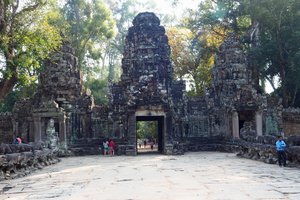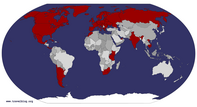Advertisement
Published: December 19th 2016

 Preah Khan 12 century
Preah Khan 12 century
Gate into the mysteryI have just come from the Night Market. After dismissing it out-of-hand 48 hours ago, I let Noy talk me into it. My dinner restaurant was nearby, and this evening there was no other entertainment. The driver, Phol, dropped me off at what looked like the same street entrance I saw on Tuesday during my brief stroll. I carefully walked in straight lines, noting landmark shops. In truth, it was large and noisy and busy, but the goods were just regular tourist souvenirs: decorated t-shirts, loose cotton pants for women, crafty change purses, etc. A few jewellery stores glittered in the night lights (was that silver or shiny pewter or worse?). Greeting cards with elaborate paper cutwork were more in keeping with this region’s culture. Cheap restaurants were doing good business. Endless shops offered foot and full body massages, both for $1, an improbable bargain. My interest waned quickly, and I started to walk back to the hotel, pursued by touts, “Tuk-tuk, madam?” After five minutes of walking, I did not recognize my street, which should have been the first turn right. I retraced my steps and negotiated a high price for a tuk-tuk ride back to the hotel. ($1.50 instead
of the $1 suggested by Noy.) Unlike in India where the passengers huddle in a two-seater metal taxi built onto the motorcycle, here the motorcycle tows a four-seater wagon. The breeze blew my hair while the wagon bounced softly over the potholes and speed bumps! The ride was more fun than the Market!
Today we saw so many temples that I needed my photo notes just to write these travel notes. We visited several of what might be called the lesser sites. Some were seventh century, that is, from the beginning of temple development. Because these temples are less curated and less restored, trees grew on top of, around and through buildings and walls, culminating in the day’s final temple, nicknamed “The Jungle Temple”. All the buildings suffered from nature having destroyed the roofs (rain, sun, vegetation), exposing the interior decorations to erosion. Miraculously, carvings sheltered by corners or small overhangs look clean and new.
After only two days, the basics of Cambodian Hindu temples are familiar. They are multi-building complexes on rectangular or square sites surrounded by walls made of lava rock. Four gates on the compass quadrants give admission, although always the east gate is the
formal one, except at Angkor Wa because it is a funerary temple for the king. The temple building is usually on three levels, sometimes with the third one being significantly higher than the others. The main tower or the temple itself is on an artificial hill, i.e., a rock podium, because Cambodia doesn’t have natural hills in this area. Many temples have five towers, one being the main tower and thus the highest. While the foundations and walls are lava rock, the carvings are done in sandstone, and the meanings range from decoration to worship to “documentation” of the building of the temple. Today we saw brick temples, which are the earliest ones. All the temples were “lost”, most for over two hundred years, again with the exception of Angkor Wa that was lost for 60 years including 30 years of civil war. UNESCO and interested countries are paying for the restoration; the operation of the temple visiting has been contracted out to a private company and a fifth of the profits come to the government. (“Corruption”, complains Noy.)
First we visited the
Preah Khan Temple. The processional entrance was lined with Buddhist stele, from which the faces of Buddha had

 Victims of Landmines musical group
Victims of Landmines musical group
...playing traditional Khmer songs been chipped off later by the Hindus. The temple grounds were 800 metres on a side, with large female mythical birds every 25 metres, each the full height of the wall, probably 3 metres. The wall was lava rock, which gave it a reddish appearance. Stumbling was inevitable as Noy slowly led the way, because inside, at the base of each tower, was a pediment for the now non-existent statue (stolen). At the time, ease of access was unnecessary, because only the high priests went inside the buildings for worship. Angkor Wa had 33 high priests; lesser priests worked in towns and villages. Sometimes it seems members of the royal family were allowed inside, but usually they remained outside also. Of course, the weather and enemies effaced much of the documentation etched on sandstone blocks that were incorporated into columns.
As we slowly left for the parking lot, I heard then saw a musical group. The players were all victims of landmines. Glad to help out by buying their CD as an excellent soundtrack to my videos.
We drove a bit to
Mebon Temple, built for the public in 952. The towers were built from local bricks, about two-thirds
the size of a modern brick and reddish yellow in hue. The structural elements, such as windows and doors were sandstone, and as usual, the foundations were lava rock. On each corner were full-size elephant statutes, shamefully broken by looters. “Inside”, that is on the second level, the elephants were smaller and in the same relative positions. Noy pointed out a good drainage system that included snake gargoyles to direct the runoff. In an appreciation of practicalities, on all five towers the south, west, and north doors were false, acknowledging that the priest would use only the ceremonial doors on the east. At the base of the towers was only a small room for worship practices.
Another short drive took us to
Pre Rup Temple, built by the Mebon king for himself (
Rajendravarman). Later the temple was rededicated to
Shiva by another king, and in the sixteenth century it was taken over by Buddhist monks who used it as a crematorium, thus its current association with death. A number of tourists were hazarding the steep, narrow stairs to the main tower, but Noy took me around to one side to 43 modern wooden steps.
Our final temple before lunch was

 Kaliyan Mith restaurant
Kaliyan Mith restaurant
Delicious courses served in the cool shade of big trees. Dating from 921, all five relatively simple brick towers were simply built in a row, providing little more than large niches for worship. The carving was done directly into the brick and is well-preserved, particularly the carvings of Vishnu’s wife who embodies perfection of wisdom. The age of the temple prioritized its restoration.
Lunch was a refreshing break. Marum restaurant was run by
TREE Alliance, a charity that trains disadvantaged young people for a trade in the hospitality industries. The staff had t-shirts labeled “teacher” or “student”, and the service was impeccable. Coincidentally, the grilled chicken and crispy fish dishes were the same as last night, although more carefully and tastily made. The appetizer was so delicious I discussed how to make it with the server: long eggplant (roasted then steamed), garlic, and two kinds of chilli peppers, all chopped very fine, seasoned with salt and a little sugar. This dip was served with “India crackers”, similar to poppadum. A shop attached to the restaurant sold student-made crafts, most of which didn’t interest me. Until I came to the jewellery made from spoons and forks! The cutlery shapes were disguised by being flattened and reshaped into bracelets, rings and
necklaces!
Resuming our temple tour, we visited
Banteay Kdei, a memorial temple built to honour the king’s teacher, by King Jayavarman VII,the same king who built
Bayon (twelfth century). He built half a dozen temples within a 36 year time period, all at the same time. This site has not been restored, only cleared of destructive trees; the towers were banded to keep the rocks from falling down. The foundation, exposed in one place, dates from the seventh century when a completely different temple was on the site.
Another short ride brought us to the memorial temple built by King Jayavarman VII for his mother. The walls of
Ta Prohm are 1 kilometre by 800 metres. This is a famous temple because
Laura Croft: Tomb Raider was filmed amongst the natural destruction of the walls and buildings. To ensure the preservation of the site, stunts were done on fabricated replicas. Gigantic
Silk Cotton,
Ficus and
Teak trees have grown up, around and inside the stonework. Seeking moisture during the dry seasons for over 300 years, they sent roots through tiny holes in the resin caulking, eventually cracking the seal and prying apart huge structures. Now their treetops soar high into the sky. Their visible

 Five towers of Kravan Prasat
Five towers of Kravan Prasat
Entirely different style of recognizable architectureroots are the size of human thighs, wrapping the historic sculpture architecture in a too-loving embrace. The only curation (by UNESCO) is to check annually for diseased trees, which are cut. The hidden root systems are so strong and extensive that a tree cut in one place will be alive and still growing in another. Some trees have become so grown into the buildings that they provide structural support for the crumbling rocks, even as the roots cause more crumbling conditions.
Exhausted with walking in the heat, we returned to the city. I had a nap and a swim, very cooling. Dinner was at a Cambodian restaurant in town – so happy the tour company ensures meals are Cambodian food. Only problem is that the serving sizes are deceptively large. For example, this evening the appetizer was the size of a good lunch, and both the main course and the fish course would each have served as dinner. (Noy says the Asian tourists like to eat!) All the set menus have five courses.
Dinner: tiny fruit salad in a cucumber “bowl”; tempura zucchini and frangipani flower, crispy sticky rice, spicy chicken, fresh spring roll; beef slices with fresh
greens; fish amok; sweet sticky rice with lychee and mango; and an Angkor beer
">View a glimpse of the Victims of Landmines musical group.



























Isabel Gibson
non-member comment
Meals
What a busy and interesting day. I don't think I've ever had Cambodian food. Thai and Vietnamese, of course, but not Cambodian. Does it have the same heat options as those others? And if so, is it an integral part of the dishes or in sauces on the side?